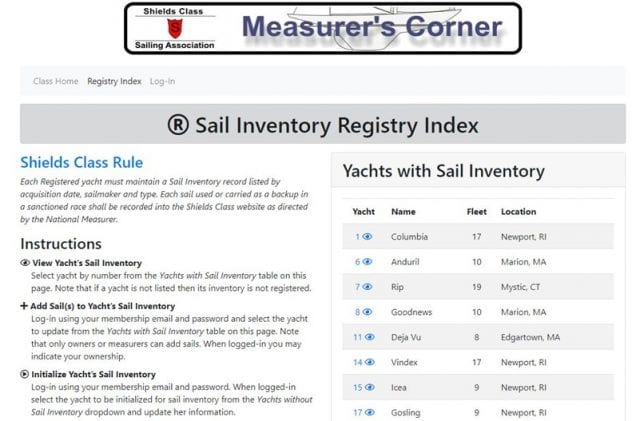By Eric Anderson, Past President of the Shields Class
The Shields Class has held its National Championship every year since 1964 with two recent exceptions. In September 2017, Hurricane Jose’ sat menacingly about 50 miles off Southern New England while nationals’ entrants huddled inside Mason’s Island Yacht Club near Mystic, Connecticut, forcing the cancellation of the 53rd Shields National Regatta. With this year’s nationals scrubbed due to COVID-19, that made two National Championships scrubbed in a short four years.
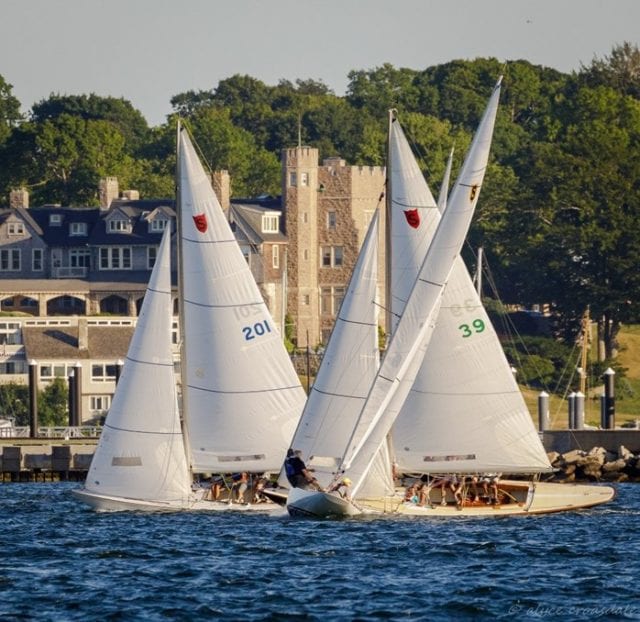
How is it that a one design class can be so optimistic given its recent setbacks and amidst the current global uncertainty? A short list of reasons can be summarized: passion, organizational strength, strong communication, and holding steadfast to the Shield’s rigid one design class rules.
First, and most importantly, Shields owners are passionate about their boats.
Many Shields have been “in the family” for decades and are now being campaigned by second and third generations of the original owners. Each of our fleets have come close to folding at one time or another for a variety of reasons, only to have the energy and enthusiasm of a critical few carry on during the down times until the fleet was revitalized. Sometimes this was the result of owners buying additional boats and keeping them viable until a new owner could be found. Skippers and crew look forward to our Nationals each year, not just to see a new champion crowned, but equally to see old friends and renew acquaintances from around the country.
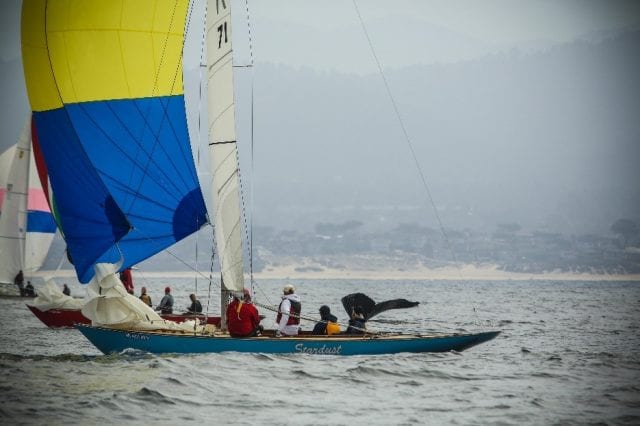
The class pivoted with COVID, providing guidance to class members and fleets.
The Governing Board, in a May meeting, collectively addressed the needs of fleets/sailors who were anxious to be out sailing. Facing daunting challenges posed by various states’ rules for sailing, coupled by yacht clubs not opening as well as cancellations and postponements of scheduled races, the Shields Class responded with great collective vigor. Where Race Committees could not be arranged, we used rabbit starts. When clubs cancelled events altogether, we sailed informally as a fleet or sometimes just a single boat or reduced crews to three people instead of the usual four or five to conform with social distancing guideline. Wherever there were Shields, there was sailing.
Solid structure and consistent leadership is critical to class health and well-being.
Another reason we have enjoyed continued success as a class is a strong organizational structure and leadership. The class has 10 elected officers who meet monthly, including over the winter to handle the business end of things. Each fleet has a fleet captain and measurer while some of the larger fleets have even more officers. Several standing and ad hoc committees meet as needed to address items like class rules, youth participation at the fleet and national level, national regatta courses, marketing, fleet development and other items as required.
Communication is key!
The class has been publishing its written newsletter, The Masthead, twice a year for decades. Starting in 2018, we began issuing two additional e-Masthead issues each year to keep the news flow strong across the class. The current issue and all archived issues are hosted on our website and can be viewed/downloaded at https://shieldsclass.com/home/newsletter.php. Periodic emails and e-blasts have complemented our upgraded communications strategy in recent years.
If the class rules work, no need to fix ‘em!
The Shields Class has been rather dogmatic about the class rules which were conceived to promote competitiveness across its fleets. Adherence to the class rulebook as an unquestioned strength of our class. Survival for one design classes everywhere has largely depended on casting a wide net in the hopes of attracting new members to the class. Some classes have felt pressure to relax class rules to allow further and further deviations over time. Some classes choose fewer rules from the onset. Though the it has faced a similar decrease in numbers of skippers, boats, crews and fleets as many other one-design classes, the Shields Class has remained steadfast in its commitment to a strict one design rulebook, making success on the race course primarily due to the skill and execution of the crew.
Taken directly from the Shields Class Constitution, Section I, Article 2, “The objects of the Association are to promote Corinthian racing of Shields Class yachts and to maintain the one design character thereof as sponsored by Cornelius Shields and designed by Sparkman & Stephens, Inc.”
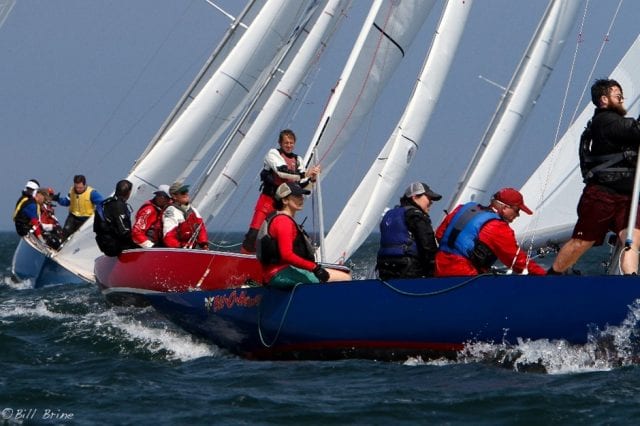
The basics of Shields Class Rules can be summarized into three primary categories: boat, sails and crew.
Boat Rules and Regulations –
Throughout its 57-year history, Shields have been produced by three separate builders. These are Cape Cod Shipbuilding, Chris Craft and Hinckley Yachts. The original molds from Hull #1 remain in use today. All required equipment is called out in the rules. What is not permitted is prohibited. With the exception of a handheld VHF radio and micro compass/start sequence timer, no electronics are allowed while racing. The class is committed to keeping all boats competitive. For example, in the early 2000s, a major effort was undertaken to formalize a rule and a practical enforcement regime to regulate the placement of mast steps. The Diagram below shows the measurement protocol used for determining the max forward position a yacht’s mast step could be located based upon several measurements that are hull-specific. Each yacht must have its mast step location measured every 2 years. See diagram below.
The class remains confident in its philosophy of favoring a strict one design nature for its boats. This has worked towards the goal of keeping the competition keen and the focus on crew coordination, skill execution and tactics. This is evident in the last three National Champions. Each boat was built by a different builder, with a 45-year gap between the youngest and oldest winning boat.
Sail Limitations
Like other one design classes, the Shields Class publishes specs on sail sizes and materials but there are a couple of things that really set the Shields class apart:
- There is a restriction on purchase frequency of sails, limiting each registered boat to a single sail credit per year. The class commitment to this approach tends to prevent an “arms race” where one or a few owners can simply outspend the others with multiple costly new sails every year.
- In order to be eligible for use in the National Regatta, each sail used must have seen action in at least 10 club races during that year. All sails are “measured in” each spring by the fleet measurer who writes the date of measurement and their initials on the tack. The traditional sail card which listed each yacht’s registered sail inventory has given way to an online class sail registry hosted on the class website.
Crew Compliance
Every racing class is flattered when professional sailors are attracted to it. This not only ups the level the talent and enhances competition, but it also lends an element of prestige to the class reputation. The Shields Class is no different. However, we do have requirements for professionals to ensure that they are committed members of the class prior to entering the National Regatta.
Every helmsperson and every professional sailor, as defined by World Sailing Regulation 22, Sailor Classification Code, must have competed in 10 sanctioned Shields races that season as certified by a local fleet.
Our largest fleet in Newport, RI, counts many professional sailors among its members.
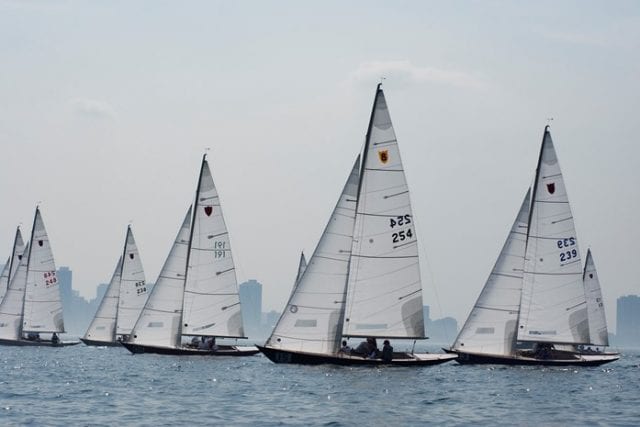
Conceived by Cornelius Shields in the early 1960’s as a modern fiberglass revival of his cherished IOD class, this Sparkman and Stephens design remains among the finest one design sailboats ever produced. With active fleets sailing throughout the Northeast, Chesapeake Bay, Lake Michigan and California, Shields are raced by sailors who love to compete, hank on their jibs and determine VMG without consulting polar diagrams or using their smart phone. At 30′ this 4,300 lb. keelboat will impress with its ability to perform on windward legs and will delight the crew by driving deep while running. Staying true to its original charter since conception, the Shields continues to capture the essence of one-design yacht racing. Come Join in the fun! Please contact at us info@shieldsclass.com.

Eric Anderson is a Past President of the Shields class who continues to serve on its governing board and is an avid racer/boat owner from the Monterey, Calif. fleet which is routinely joined by humpback whales and other interesting forms of wildlife!


